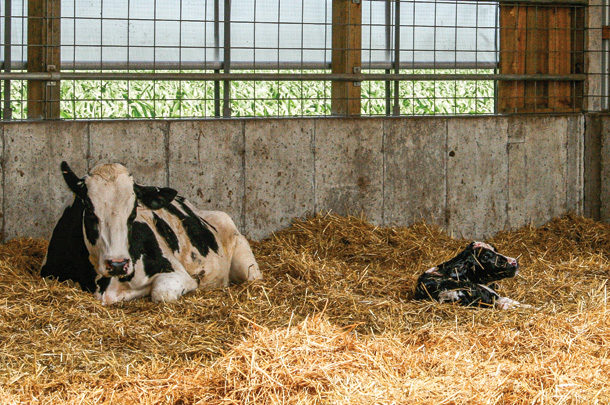Uterine health disorders rarely result in the death of a cow, but they can impact the entire lactation of a cow, not just the transition period.
On average, one case of metritis costs the farm $512 and affects more than the uterus. A study published in 2021 in the Journal of Dairy Science shows three main categories of concern when it comes to the cost of metritis and the impact of the illness:
- Milk yield: Cows with metritis produced 1,794 pounds of milk less than cows without metritis at the beginning of their lactation.
- Reproduction: Metritis cows resulted in 10% fewer pregnancies and increased days open than non-metritis cows.
- Cull rates: The cull rate also increased by 9.4% in cows with metritis.
With treatment costs at almost 20% of a cow’s profit margin, metritis is a very costly disease to treat. So rather than dealing with metritis’s hidden costs, how can you proactively manage uterine health challenges?
Simple practices to improve uterine health
Prevention, rather than treatment, should be the focus when dealing with uterine health. Proper management can lead to fewer uterine health issues. Simple practices such as providing clean bedding, ensuring hygienic facilities and other environmental factors can play a large role in a cow’s health, but are frequently overlooked. Bedding is often replaced on a fixed schedule such as once a week; however, in a maternity pen, this may not be enough. In calving areas, bedding schedules should reflect the calving season and how many calves are being born at that time. The more cows calving, the higher the bacteria load. In addition to replacing bedding, barn lime or bleach should be used as a simple disinfectant in calving areas.
Nutrition also plays a very important role in preventing uterine infections. A cow needs a diet that will prevent clinical hypocalcemia and provide her with the minerals needed to get through the transition period. Additionally, body condition needs to be monitored in cows prior to dry-off and throughout the dry period. Feed intakes should also be monitored, if possible, as there is a positive correlation between dry matter intake (DMI) and metritis. Essentially, if a cow is eating well before calving, she has a lower risk of getting metritis and vice versa. Additionally, cows must be up-to-date on their vaccinations, especially vaccinations that prevent bacteria such as brucellosis or leptospirosis.
Cow comfort is always important on farms but especially around a stressful event like calving. Stocking density in a maternity pen will vary; however, it is important to respect the number of headlocks and stalls in a calving area. Maternity pens should be in a quiet, neutral location where cows will not be constantly disturbed.
The first sign of a uterine health issue
A retained placenta, by definition, is the failure to expel fetal membranes within 24 hours of calving. Stillbirths, abortions, premature births, inductions, hypocalcemia and heat stress can all lead to a retained placenta before labor even starts. When a cow begins labor: Are calving protocols being followed? In order to prevent uterine health issues, it is best to leave the cow for as long as possible without pulling the calf. Hard pulls can lead to a retained placenta, leaving a door open for bacteria to enter the cow’s system. After 24 hours of a retained placenta, treatment should begin. Supportive treatments for the cow include keeping her well hydrated, providing a source of appetite or energy and being proactive on keeping the area clean. Calcium may be given, as it assists a cow in contracting the uterus.
A farmer’s concern over a retained placenta is valid. Research has shown when a cow gets a retained placenta, her chance of getting metritis increases significantly from 30% to 55% to 60%. Therefore, in many cases, if a cow gets a retained placenta, metritis will follow if not treated properly.
She gets metritis; what now?
Metritis, by definition, is an inflammation of the uterus. Proper identification of illness is essential in determining how to treat an infection. Calving is stressful on a cow, and her health may be challenged in many ways during that time. First and foremost, look at the cow and continue to look at her in the days and weeks post-calving. Early detection within the first four or five days post-calving is key. Watch for physical changes all over the cow, as they may be indicators of an infection. Is she eating? Are her eyes sunken in? Check for rumination and fever. The first 10 days post-calving are the window in which most major issues happen, and a common sign of metritis is a brown, smelly discharge.
Bacteria are often common in cases of metritis. Historically, the only option for fighting bacteria was with antibiotics. However, scientists studying bacteria have made breakthrough discoveries that are enabling us to fight bacteria in a new way by disrupting their communication, which is known as quorum sensing. Technologies that block quorum sensing give the cow’s immune system a better chance of clearing an infection without the use of antibiotics. This can help farmers care for their cows with fewer injections, provide employees safer working conditions and less risk to the food supply chain.
Once the cow has been cared for, it is important to also think about the next steps from a management standpoint. Think back to the preventative factors listed above. Was the bedding fresh? Was the cow receiving proper nutrition and vaccinations? Additionally, look to employees. A protocol may be perfect on paper, but if employees are not executing it properly, the protocol is useless. Complacency and protocol drift can be hard to spot and sometimes requires fresh eyes. If you are not happy with your numbers and need help spotting opportunities for improvement, get fresh perspective from a farm adviser.
Rather than focusing on treatment, aim to prevent uterine diseases before they become a problem. Your cows and your wallet will thank you.
References omitted but are available upon request. Click here to email an editor.






